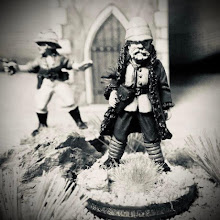To recap the origin of to what would be known in history as the "War of Great Grazing Area Succession Dispute" or simply "The Pig War" the country of the Grand Duchy of Bluehofen went to war against the Principality of Redsteinerburg in 1741 over a strip of land bordering their lands. The Grand Duke Gunter claimed the land through his marriage to Countess Gretchen who traced the claim back to her sister's husband's grandmother. Prince Leopold, on the other hand, claimed the land based on his previous marriage to the now deceased Princess Bromhilda's brother's wife's grandfather. Regardless of claim, the dispute would be settled on the field of battle in central Germany.
One-Hour Wargames, by Neil Thomas. An excellent book to introduce players to gaming - easy to learn and hard to master! It presents some challenges to experienced gamers also.
To date each country has won 4 battles earning them each 8 points. This is the final and deciding battle of the campaign and will be fought with all of the units on a 6' x 4' battlefield. The objective of the battle is simple: whichever side destroys the most enemy units will be the winner.
This is the battlefield looking from the south over the excellent farmland claimed by both nations.
The view of the battlefield from the southwest.
The famous pig farm.
A view from the northwest. Each army can set-up within 12" of their baseline. Redsteinerberg will set up first in the south followed by Bluehofen in the north. Redsteinerberg will go first.
The Redsteinerberg army deploys. Each side has 4 Infantry Regiments, 2 Cavalry Regiments, 2 units of light infantry and 2 batteries of artillery.
Bluehofen deploys in one area with cavalry in the second line. Not seen in the picture is the artillery deployed on the hill to the right of the Bluehofen line.
The Bluehofen artillery.
The battle begins as Redsteinerberg advances along the front and Bluehofen responds by repositioning their cavalry toward their right flank.
Redsteinerberg moves to seize and defend the pig farm. Bluehofen artillery fires on the main body of the Redsteinerberg army while they use the river to protect their left flank.
A Redsteinerberg brigade moves toward the village of Sauerkraut in an attempt to turn the left flank of the Bluehofen line.
The pig farm has been seized! Huzzah!
Both armies fire at long range as the both opposing lines start to take casualties.
Since the cavalry cannot attack in a village or town, it moves down the road quickly in an attempt to cross the ford and get in the rear of the Redsteinerberg army.
In a bold move, the Redsteinerberg cavalry launches a frontal attack to weaken the Bluehofen line while the other brigade gets into position on the left flank and starts firing.
The cavalry is repulses but at the cost of many a Bluehofen musketeer.
The Bluehofen line starts to take fire on their left flank as they fire into the enemy cavalry.
The brave horsemen charge again!
A Bluehofen infantry unit is destroyed.
The Bluehofen commander uses a cavalry unit to plug the whole while the other regiment hits some of the Redsteinerberg artillery from the rear. In addition, the Redsteinerberg skirmishers near the pig farm are destroyed by mass artillery fire. Bluehofen musketry destroys an enemy cavalry unit. The morale of the Redsteinerberg generals start to drop.
The Redsteinerberg infantry unit leaves the village and moves to outflank the Bluehofen line. Meanwhile the firing of the Redsteinerberg units on the left flank of the Bluehofen line starts to take a toll on the units on that flank.
The Bluehofen line starts to fall apart on the left flank as the Redsteinerberg brigade across the river fires unopposed.
An attempt to stabilize the line.
The Bluehofen army has become disjointed and is taking attacks from all sides; however, the Bluehofen artillery continues to cause casualties and weaken Redsteinerberg units.
Redsteinerberg is down to 7 units while Bluehofen has 6. (Bluehofen artillery and lone cavalry unit not in this shot!)
The brigade took advantage of the cover of the town.
In the very last turn of the game, Bluehofen loses another unit and Redsteinerberg loses 2 units to artillery fire. Both sides destroyed the same amount of the units and the game ends in a tie!
With a tie, each side gets 1 point and the final score of the campaign is 9 - 9. Some of the great powers step in, a treaty is signed and all enjoy a feast of beer and bratwurst. What a great semester and I must say I had some great students fighting over central Germany! Well done.






















































